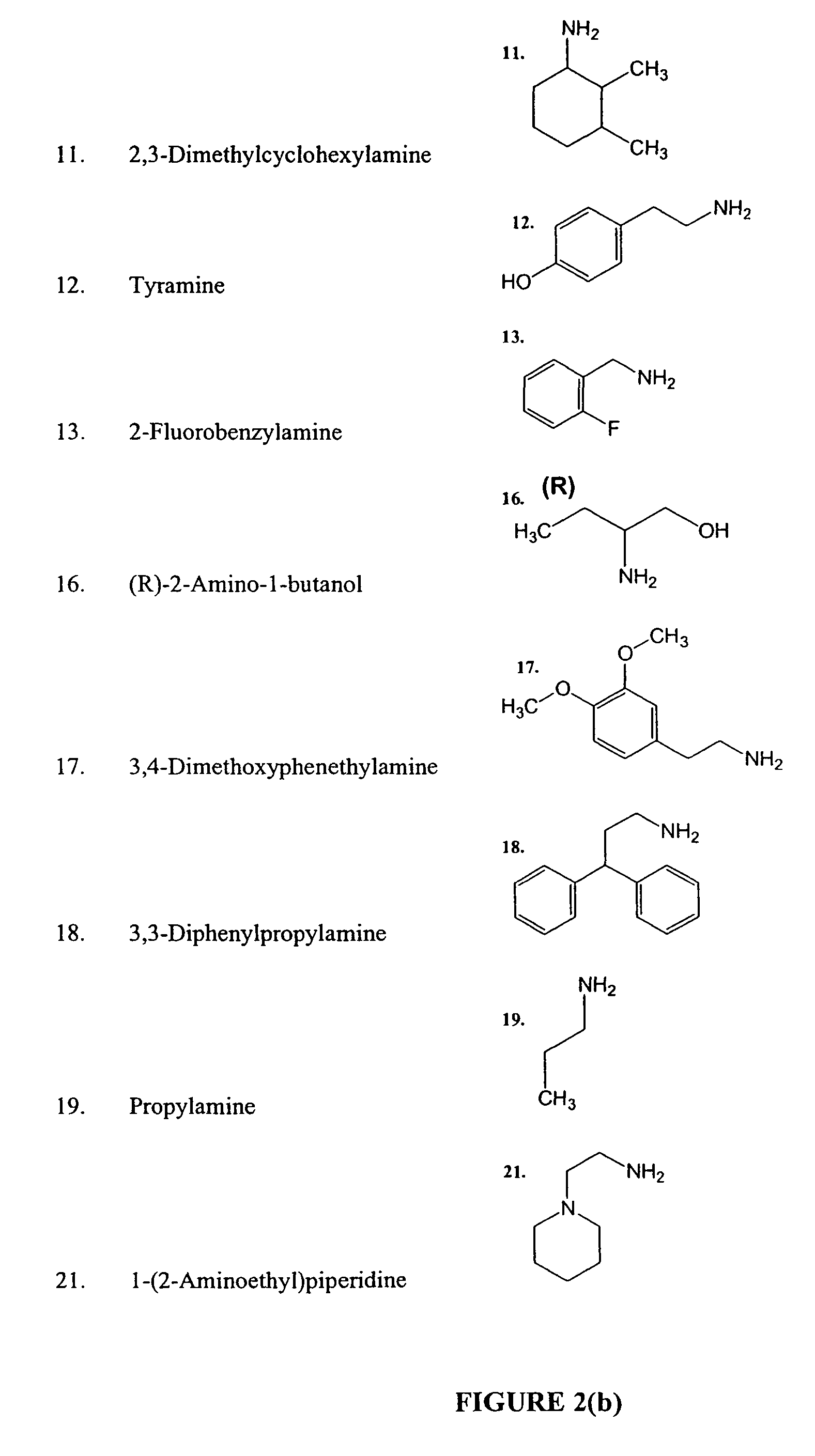Anti tubercular drug: compositions and methods
a technology of compositions and drugs, applied in the field of compositions and methods for treating diseases caused by microorganisms, can solve the problems of overwhelming, mycobacterial diseases still constitute a leading cause of morbidity and mortality in countries with limited medical resources, and the number of patients with immunocompromised disease is large, so as to improve the anti-mycobacterial activity and improve the anti-tuberculosis activity.
- Summary
- Abstract
- Description
- Claims
- Application Information
AI Technical Summary
Benefits of technology
Problems solved by technology
Method used
Image
Examples
example i
Generating the Ethylene Diamine Library
[0154]The Rink-acid resin was obtained from NOVABIOCHEM® Inc., San Diego, Calif. Solvents: acetonitrile, dichloromethane, dimethylformamide, ethylenedichloride, methanol and tetrahydrofuran were purchased from ALDRICH®, Milwaukee, Wis., and used as received. All other reagents were purchased from SIGMA-ALDRICH®, West Monroe Highland, Ill. Solid phase syntheses were performed on a QUEST® 210 Synthesizer, from ARGONAUT TECHNOLOGIES®, Foster City, Calif., with the aid of combinatorial chemistry equipment, from WHATMAN® POLYFILTRONICS® (Kent, England; Rockland, Mass.) and ROBBINS SCIENTIFIC®, Sunnyvale, Calif. Evaporation of solvents was done using SPEEDVAC® AES, from SAVANT®, Holbrook, N.Y. All necessary chromatographic separations were performed on a WATERS' ALLIANCE HT SYSTEM®, Milford, Mass. Analytical thin-layer chromatography was performed on MERCK® silica gel 60F254 plates, purchased from SIGMA-ALDRICH®, West Monroe Highland, Ill.
[0155]The a...
example ii
Deconvolution Example
[0171]Deconvolution of the active wells was performed by re-synthesis of discrete compounds, from the archived α-haloacetyl amide resins (10 resins, 0.05-0.10 g each), which were set aside at the end of the acylation step before the pooling. Each resin was assigned a discrete column (1, or 2, or 3, etc., see the template) in a 96 well filterplate, and was divided between X rows (A, B, C, etc), where X is the number of hits discovered in the original screening plate. To each well, in a row, a selected N2 (R3R2NH) hit amine (0.1 mmol), DMF (180 ml) and EtNiPr2 (20 ml) were added: the first selected amine was added to the resins in the row “A”, the second amine—to the resins in the row “B”, the third amine—to the resins in the row “C”, etc. A lay-out of a representative 96-well filter plate is shown in Table 4.
[0172]The reaction plates were sealed and kept in an oven at 70-75° C. for 16 hours. After cooling to room temperature, the resins were filtered, washed with...
example iii
Solid-Phase Synthesis of Selected Substituted Ethylenediamine Compounds Using the QUEST® 210 Synthesizer
[0174]The solid-phase protocol described above in Example I was applied to the scaled-up synthesis of the selected substituted ethylene diamine compounds. Here, all reaction steps, from the activation of the Rink-acid resin to the cleavage of the final product, were carried out using the QUEST® instrument only, which allowed for the simultaneous syntheses of twenty parallel reactions. Purification of all crude samples was done by HPLC to yield desirable products in purity greater than 90%. Table 3 lists the scale-ups of substituted ethylene diamines. Here, the synthesis of one of the active compounds, N-Geranyl-N′-(2-adamanthyl)ethane-1,2-diamine is described below as an example.
[0175]The Preparation of N-Geranyl-N′-(2-adamanthyl)ethane-1,2-diamine (compound 109) is set forth in FIG. 12.
[0176][0177]1. Activation of the Rink-acid resin. Synthesis of Rink-C1 resin. Rink-acid resin, ...
PUM
| Property | Measurement | Unit |
|---|---|---|
| Minimum Inhibition Concentration | aaaaa | aaaaa |
| volume | aaaaa | aaaaa |
| temperature | aaaaa | aaaaa |
Abstract
Description
Claims
Application Information
 Login to View More
Login to View More - R&D
- Intellectual Property
- Life Sciences
- Materials
- Tech Scout
- Unparalleled Data Quality
- Higher Quality Content
- 60% Fewer Hallucinations
Browse by: Latest US Patents, China's latest patents, Technical Efficacy Thesaurus, Application Domain, Technology Topic, Popular Technical Reports.
© 2025 PatSnap. All rights reserved.Legal|Privacy policy|Modern Slavery Act Transparency Statement|Sitemap|About US| Contact US: help@patsnap.com



